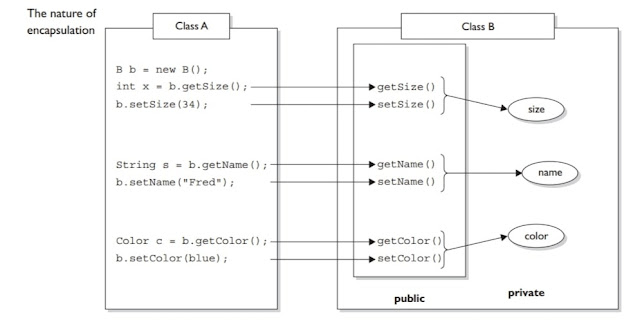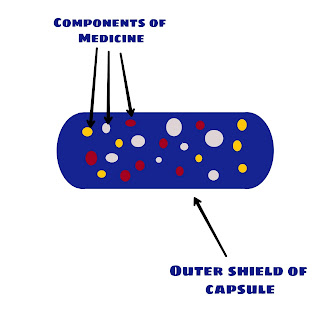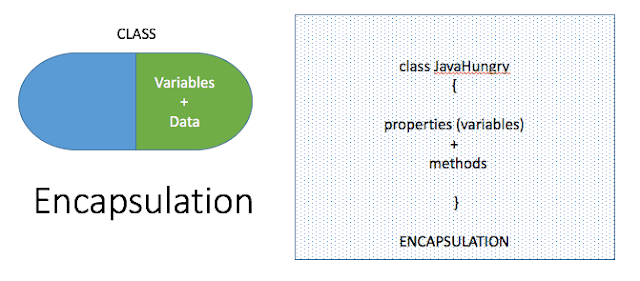Encapsulation is considered as one of the core features of any Object-Oriented Programming Language.
The classical definition of Encapsulation states that Encapsulation is the process of wrapping the data (variables) and the code associated with those data (methods) within a single unit.
Read Also: Difference between Method Overriding and Method Overloading
Introduction to Encapsulation in Java:
As we have discussed earlier, Encapsulation is one of the core concepts of java. In Java, it can be achieved by declaring all variables (data) as a private member and associating these variables with the public get and set methods.The variables are declared private, the members of other class can’t access the data of encapsulated class directly until the get or set methods are used. Thus, data of encapsulated class are hidden from other classes. Due to this reason, Encapsulation is also called as Data Hiding.
In this concept each member is associated with two kinds of methods:
Setter Method: This method is used to set the value of a private member of the encapsulated class. It takes a value as an argument and assigns that value to the private member. It is written as follows:
public void setMember(datatype value) { this.value = value; }
Getter Method: This method returns the value of the private member of the class. It is written as follows:
public datatype getMember() { return value; }
Real-Life Example of Encapsulation:
Let’s understand the concept of Encapsulation with the help of a real-life example. For example, consider a Capsule (Medicine). The powder of the capsule consists of various components as well as the outer shield of the capsule protects the internal components from the outer environment. In a similar way, with the help of Encapsulation, we can wrap data and code as a single unit and protect it from outer code.General Syntax:
public class JavaHungry { private datatype sampleMember1, sampleMember2; public void setMember1(datatype value) { this.sampleMember1 = value; } public void setMember2(datatype value) { this.sampleMember2 = value; } public datatype getMember1() { return sampleMember1; } public datatype getMember2() { return sampleMember2; } }
The general syntax for encapsulation in Java is shown above. The members of the class are declared private whereas the methods to get and set the values of these members are declared as public. Thus, the outer classes can’t access the members directly instead they have to use these public methods.
Example for Encapsulation:
//Bank.java (Java file containing Encapsulated Class) class Bank { private String branchName; private String branchCity; private int branchPin; public void setName(String value) { this.branchName = value; } public void setCity(String value) { this.branchCity = value; } public void setPin(int value) { this.branchPin = value; } public String getName() { return branchName; } public String getCity() { return branchCity; } public int getPin() { return branchPin; } }
In the above java program, we have created an encapsulated class Bank containing branchName, branchCity, and branchPin as private members. The getter and setter methods are created for each of these private members.
//TestEncapsulate.java (Java File Containing main() method) public class TestEncapsulate { public static void main(String args[]) { String name, city; int pin; Bank bank = new Bank(); bank.setName("Sample Bank"); bank.setCity("Sample City"); bank.setPin(100000); name = bank.getName(); city = bank.getCity(); pin = bank.getPin(); System.out.println("Branch Name: "+name+"\n City: "+city+"\n Pin: "+pin); } }
Output:
Branch Name: Sample Bank
City: Sample City
Pin: 100000
Advantages of Encapsulation:
1. Data Hiding: Encapsulation provides a protective shield to the members of a class and prevents it from the outer code. The user will not know how and where the data is being stored. Users will be unaware of the inner implementation of the class. Therefore Encapsulation provides the facility of Data Hiding from outer classes and users.2. Flexibility: Encapsulation creates the code more flexible. There is no need to worry about how and where to store data as well as how to access them because getter and setter methods do these functionalities.
3. Reusability: The code becomes more useable as it’s easy to change the encapsulated class with the change of requirements.
Test Your Knowledge:
Q1. Consider The Following Image:
Can Class A access Class B instance variable data?
No, Class A cannot access Class B instance variable data as they are declared as private. Although, the data of the instance variable of Class B can be accessed using the getter and setter method. In Class B, the variables size, name, and color are declared as private. In order to make these data available for class A, public getter and setter methods are created. The data of class B can be accessed using getter methods and can be set using setter methods.
Q2. Consider the following class:
class Person { public String name; public String address; public int contactNo; public void setName(String name) { this.name = name; } }
Is this an encapsulated class? If no, justify your answer and convert it into an encapsulated class.
Ans. No, it is not an encapsulated class because all the variables are not declared as private. Therefore it can be easily accessed and updated by outer code. In order to make this class encapsulated, we need to declare all necessary variables as private and create getter and setter methods for each of them.
The above class can be restructured as follows:
class Person { private String name; private String address; private int contactNo; public void setName(String name) { this.name = name; } public String getName() { return name; } public void setAddress(String address) { this.address = address; } public String getAddress() { return address; } public void setContact(int contactNo) { this.contactNo = contactNo; } public int getContact() { return contactNo; } }
That's all for today, please mention in comments in case you have any questions related to encapsulation in java with examples.
You may also like:
Method Overloading in Java
Method Overriding in Java
Difference between Method Overloading and Method Overriding in Java
Variable Shadowing and Variable Hiding in Java

